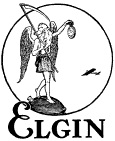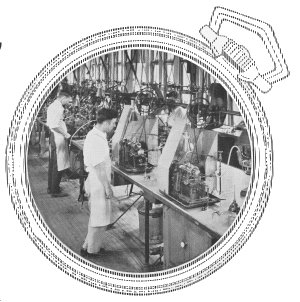Know Your Product

Know Your Product |

|

|
Part 2, The Gilding Department, The Watch Word, December 1935James G. ShennanEditor's Note - This is the second of a series of articles on the manufacture of a watch as conducted in the factory of The Elgin National Watch Company. It is our hope to acquaint our readers with the work of departments other than their own. |
|
||
|
The general function of the Gilding department in the production line is to put a finish on the watch plates, which are received from the Plate department completely machined, but with surfaces unfinished, and to put the finished jewels into these plates. In addition, the jewels, which are received unset, are set in brass settings so as to facilitate fastening them securely into the plates. The settings are later given a finished polish known as stripping. The top plates are first surfaced on a steel wheel covered with a medium grade of emery paper. They are then given a quick dip in concentrated nitric acid, which removes all dirt and stain, and leaves them clean and bright for subsequent operations. Seven-jewel watches are next put on semi-automatic machines which cut in the endshake to the proper length. The final surfacing is also done on a steel wheel which is covered with a much finer grade of emery paper than that used on the preliminary surfacing, or stoning, as it is called. The only industry using as fine a grade of emery paper as used on final stoning, is by the manufacturers of copper plates for rotogravure printing. The finished surface you see on a watch plate is called a damaskeened finish. It is done by going lightly over the plate with a hollow ivory lap about three-fourths of an inch in diameter revolving at 13,000 revolutions a minute. Minute curved grooves are cut into the metal, gIvmg, when completed, a satin appearance which breaks up and heightens the reflection of light. This finish is necessarily delicate and must be handled carefully, because a cross section of the plate would show the damaskeened surface to resemble the furrows of a ploughed field in shape, but only one or two ten-thousandths of an inch deep. The top of these ridges are easily dented resulting in a scratched appearance. |
|
|||
|
The backs of lower plates are sometimes pearled. Pearling is done with a small felt lap which is pressed down on the metal making a small polished circle. These polished circles are overlapped giving a mottled effect. On watch plates the finish must be applied before the watches are nickel plated because plating changes only the color of the finish, not the texture or appearance of it. Finishing the surface before plating is contrary to o~dinary pro~edure and hence brings up umque and dIfficult problems of cleaning and plating. Cleaning before plating is the most important factor in obtaining a brilliant, flashy plate. The method we use is to soak the plates in a solvent, then to spray them with kerosene and air under sixty pounds pressure. This washes the damaskeening abrasive off the plates and out of the recesses and leaves them clean and bright. After several preparatory dips the plates are hung in a nickel p~ating bath for two minutes and a coatlllg of approximately three hundred-thou.sandths of an inch of nickel is deposited on them. After the plates are dried they are in the finished condition in which you see them in completed watches. Depositing the nickel on the plates is accomplished by a process call:d electroplating. To scientifically explalll electroplating of nickel would occupy more space than can be taken in this article, but perhaps a general idea of t?e p~ocess can be obtained by companng It to sprinkling a lawn with water conducted through a hose from a distant tank. In nickel-plating, the watch plates can be Likened to the lawn, strips of pure nickel to the water in the distant tank, and the green nickel-plating solution to the hose. In the illustration, water is transported from the tank to the lawn; in nickel-plating, microscopic particles of pure nickel called ions, are transported from the strips of nickel to the plates. The solution conducts the ions of nickel like the hose conducts the water. Gravity is the force that moves the water from the tank through the hose to the lawn; electricity is the force that removes the ions of nickel from the strips hung in the plating tank, moves the ions through the solution and causes them to adhere to the plates which are also hung in the solution. Just as the water, impelled by gravity, flows from the tank through the hose and covers the lawn, likewise ions of nickel, impelled by electricity, move from the strips of pure nickel through the solution, and cover the plates with a very thin nickel coating called a ,nickelplate. While the plates are being damaskeened and plated, the jewels, which had been inserted in an unfinished state into the plates by the Plate department, and had been removed in the Gilding department before final stoning, are being given a finished polish by hand. This operation is known as stripping and c~nsists of cutting away excess brass With a sapphire cutter, leaving a highly polished surface. Sapphire cutters are used because they are very hard and, therefore, can be given a keen, highly polished cutting edge which leaves a similar surface where the cuts are made. When the watch plates have passed plating inspection, the jewels are put in and held in place with tiny screws. Because of the susceptability of a damaskeened surface to scratches and stain from perspiration corrosion, no finished plates in the Gilding department are handled with bare fingers, brass tweezers and chamois finger cots being used at all times. Fingerprints and stains can be removed by wiping the plate with a buff stick moistened with benzine, but every wiping leaves a film over t~e nickel which clouds and dulls the onginally bright appearance of the watch. Careful handling has eliminated the necessity for wiping with buff sticks. After the jewels have been put in place, the watches are given a final inspection and, when passed, are delivered to the Assembling department. The jewel division of the Gilding department is concerned with set~ing synthetic ruby jewels in brass settlllgs and fitting them to the train and balance wheel pivots. The manufacture ?f sy?thetic ruby jewels has been explallled III a previous article so we will take the un set jewels in the finished condition and describe the process they are put through before they are sent to the Plate department to be put in watch plates. Since jewel setting is done on automatic machines, the unset jewels must be loaded into magazines or tubes from which they are fed automatically into the brass wire which eventually becomes the setting. Jewel loading is done on a battery of ingenious machines which not only reject a jewel when it is about to be loaded upside down, but which also stop automatically when the magazine is filled, and signal the operator. These loaded magazines are put into a machine which automatically cuts a recess in the end of a piece of brass wire, blows the jewel into the recess, burnishes the jewel into the recess in the wire, turns the outside diameter of the wire to the correct jewel setting size, and cuts off the wire to the proper length, thereby completing the setting. These machines turn out approximately fourteen finished settings a minute. At the present time about 1,500,000 jewels are being set every month. After the jewels have been set, the jewel settings are put on small indicating lathes to test the concentricity of the hole with the outside diameter. The settings are next inspected and then gauged for jewel hole size and, if passed, are ready for fitting to the pivots. Jewel fitting consists of fitting jewels to pivots of wheels so that there will be sufficient sideshake or clearance between the hole in the jewel and pivot. If the jewels are fitted too closely, the wheel will not run freely in the watch; if fitted too loosely there will be excessive freedom resulting in disturbance of the relation of each wheel to the next, causing poor timekeeping qualities in the finished product. Each pivot is fitted individually to a side shake of four ten-thousandths of an inch. After having been fitted, the jewels are put in trays in an order corresponding to the assigned serial number of the wheel to which they were fitted. The train jewels are then sent to the Plate department where they are put i~to watches, the serial numbers of which correspond to the number assigned to the holes in the jewel trays. Hence, when the watches get to the Assembling department, the pivots of wheels assigned to a certain numbered watch will fit the holes of the jewels in that watch. Balance jewels and endstones are stripped and fitted into the watch plates in the Gilding department as has been explained. In addition to the above mentioned production line operations, all miscellaneous plating of parts, except dials, the manufacture of jewels used in gauges and machinery, and the manufacture and sharpening of all diamond cutting tools is done in the Gilding department. |
||||
|
||||
|
|
||||

|
|
|||
|
|
||||
Comments to jsexton@elgintime.com